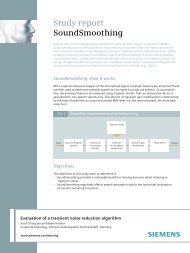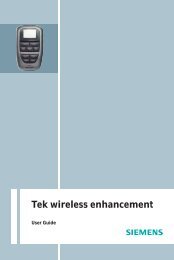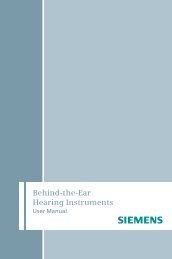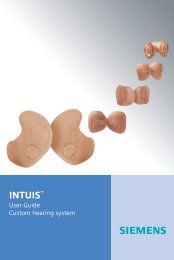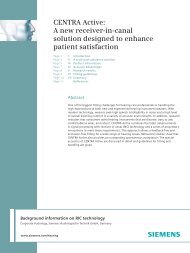Music Pro User Guide ITE - Siemens Hearing Instruments
Music Pro User Guide ITE - Siemens Hearing Instruments
Music Pro User Guide ITE - Siemens Hearing Instruments
You also want an ePaper? Increase the reach of your titles
YUMPU automatically turns print PDFs into web optimized ePapers that Google loves.
MUSIC <strong>Pro</strong><br />
<strong>User</strong> <strong>Guide</strong><br />
In-the-Ear <strong>Instruments</strong><br />
<strong>Siemens</strong> <strong>Hearing</strong> Solutions<br />
s
A friendly guide to your<br />
new <strong>Siemens</strong><br />
hearing instruments<br />
Congratulations!<br />
You have decided in favour of hearing instruments from<br />
<strong>Siemens</strong>. You have taken an important step towards being<br />
able to hear better.<br />
From now on, your new hearing instruments will be your<br />
constant companions. You will profit from our many years of<br />
research and experience in microelectronics. Soon it will be<br />
easy for you to hear again. Good hearing is an important<br />
requirement for your physical well being. Your new hearing<br />
instruments will help you actively participate with pleasure<br />
in the world of language and music again.<br />
And as with any constant companion, you’ll need some time<br />
at first to get used to handling your hearing instruments.<br />
With a little patience, we trust that your new hearing<br />
experience will be all the more pleasant for you.<br />
These user guide should help you build friendship quickly<br />
with your new partners in matters relating to better hearing.<br />
We want to help you to handle your hearing instruments<br />
correctly, so that they will become an important part of your<br />
life.<br />
Wishing you much success,<br />
Your <strong>Siemens</strong> team<br />
2
The best way to use your<br />
new hearing instruments<br />
In this short guide you’ll find instructions about inserting,<br />
placing and adjusting your MUSIC <strong>Pro</strong> hearing instruments.<br />
There are also tips and information on correct handling,<br />
cleaning, care and battery changing. And naturally information<br />
about how you can help yourself if you cannot visit a hearing<br />
instrument specialist immediately.<br />
One important note: Your hearing success depends<br />
largely on how well your instruments fit in the ears and<br />
how carefully you maintain and handle them.<br />
Contents<br />
How your hearing instruments look like Page 4<br />
How to insert your In-the-Ear hearing instruments Page 5<br />
How to remove the instruments from your ear Page 6<br />
Switching the instrument on / off Page 6/10<br />
Battery changing Page 7<br />
Your battery type Page 8<br />
Handling batteries Page 9<br />
<strong>Hearing</strong> instruments with a program button Page 10<br />
<strong>Pro</strong>gram overview Page 10<br />
<strong>Hearing</strong> instruments with telecoil Page 11<br />
<strong>Hearing</strong> instruments with 2 microphones Page 11<br />
<strong>Hearing</strong> instruments with volume control Page 12<br />
Tips for cleaning and care Page 13<br />
The best way to handle your hearing instruments Page 15<br />
How you can help yourself Page 17<br />
<strong>Hearing</strong> training made easy Page 19<br />
3
How your MUSIC <strong>Pro</strong> In-the-Ear<br />
hearing instruments look like<br />
Your hearing instruments are custom-made according to the<br />
shape of your ears or ear canals.<br />
Compare your hearing instruments with the following<br />
diagrams. You will certainly recognize your hearing instrument<br />
type, although the outer contours can vary.<br />
6<br />
5<br />
3<br />
1<br />
1) Microphone<br />
2) Second microphone<br />
(option)<br />
3) Battery compartment<br />
Each hearing instrument can be identified by the serial<br />
number, which is located on the outside of the instrument:<br />
If the number is written in red, the hearing instrument is<br />
for the right ear, and if the number is written in blue, this<br />
hearing instrument is for the left ear.<br />
4<br />
1 2 4<br />
3<br />
6<br />
MUSIC <strong>Pro</strong> IT<br />
MUSIC <strong>Pro</strong> CS<br />
5<br />
6<br />
3<br />
4<br />
1<br />
3<br />
7<br />
MUSIC <strong>Pro</strong> CT<br />
MUSIC <strong>Pro</strong> CIC<br />
4) <strong>Pro</strong>gram button (option)<br />
5) Volume control (option)<br />
6) Vent<br />
7) Removal cord<br />
5<br />
1<br />
6
How to insert your<br />
In-the-Ear instruments<br />
Hold your hearing instrument<br />
between thumb and index<br />
finger and carefully push the<br />
instrument in the ear canal. Now<br />
bring it into the correct position<br />
by turning it slightly.<br />
You may find it helpful to pull your<br />
external ear slightly upwards or<br />
to the rear. You may want to push<br />
the instrument very gently with<br />
your index finger. Once inserted,<br />
you should feel that the hearing<br />
instrument is correctly placed.<br />
Now insert the other instrument<br />
in the same way.<br />
Tip:<br />
Practice inserting your hearing instrument correctly.<br />
One easy way to practice is to sit down at a table,<br />
place a mirror in front of you and prop your<br />
elbows on the table, so that you can move your<br />
hands steadily and safely. This will help you to<br />
stay comfortable and relaxed while you practice.<br />
5
How to remove the instruments<br />
from your ear<br />
Pull on your ear lobe to loosen<br />
the instrument in your auditory<br />
canal. You can now remove the<br />
instrument, using the thumb and<br />
index finger of your other hand.<br />
You can use the tip of your finger<br />
to push a small instrument out<br />
from the auditory canal. If you<br />
can open the battery compartment<br />
with your fingernail while<br />
the hearing instrument is still in your ear, use the battery<br />
compartment to pull the instrument out from the ear.<br />
Even smaller hearing instruments (CICs) can be removed by<br />
pulling the small removal cord while slightly pressing to the<br />
side on the ear canal.<br />
Switching the instrument on/off<br />
There are 2 ways to switch your instrument ON/OFF.<br />
First way.<br />
The battery compartment serves as an ON / OFF switch.<br />
If you want to switch the instrument on, insert the battery<br />
and simply close the battery compartment - the instrument<br />
is now ready for use.<br />
If you want to switch the instrument off, open the battery<br />
compartment all the way. To make sure that the battery is<br />
not being used unnecessarily, remove the battery from the<br />
instrument.<br />
Second way is by using the program button.<br />
If the hearing instrument has already been operated it can<br />
be switched off by pressing the program button for at least<br />
2 sec. To switch it on again press the programm button for<br />
at least 2 sec. The instrument diverts to programm “1”.<br />
Every operation is acknowledged by beeps tones.<br />
See chapter “<strong>Hearing</strong> instruments with program button”.<br />
6
Battery changing<br />
Open the<br />
battery<br />
compartment<br />
Insert the<br />
battery<br />
Close the<br />
battery<br />
compartment<br />
When inserting the battery please pay attention to the<br />
plus side on the battery.<br />
The plus (+) side of the battery is always the smooth<br />
side. You can recognise the minus (–) side by the<br />
coloured ring.<br />
You should always keep spare batteries<br />
at hand.<br />
If you feel you cannot change the battery yourself, ask<br />
someone to help you: a family member, friend or your<br />
hearing instrument specialist.<br />
7
Safety notes for batteries<br />
8<br />
WARNING<br />
Keep batteries away from children!<br />
Batteries must not be swallowed.<br />
Remove the batteries when the instrument is not in<br />
use over a prolonged period. Replace leaking batteries<br />
without delay.<br />
Do not throw away your dead batteries!<br />
Return them to your hearing instrument specialist for<br />
proper, environmentally conscious disposal.<br />
Your battery type:<br />
<strong>Hearing</strong> instrument Battery type<br />
MUSIC <strong>Pro</strong> IT<br />
MUSIC <strong>Pro</strong> CT<br />
MUSIC <strong>Pro</strong> CS<br />
MUSIC <strong>Pro</strong> CIC<br />
312<br />
312<br />
A 10<br />
A 10<br />
13<br />
Your hearing instrument specialist will inform you which<br />
hearing instrument and which battery type you need.
Handling batteries<br />
Zinc-air batteries are used<br />
today almost exclusively in<br />
hearing instruments to<br />
minimise environmental<br />
damage. These batteries<br />
require oxygen for operation,<br />
which they absorb from the<br />
air. The battery is activated as<br />
soon as the protective foil is pulled off and is used up even<br />
if you do not use your hearing instrument.<br />
You should always pull off the protective foil only when you<br />
actually use the battery. Also, do not leave the batteries in<br />
your INFINITI <strong>Pro</strong> hearing instruments if you do not use them<br />
over a longer period of time. The batteries can leak and damage<br />
the instruments. The batteries can last for a few days<br />
up to several weeks according to the way they are used.<br />
You can recognise when a change of batteries becomes<br />
necessary, because your hearing instruments become<br />
noticeably quieter towards the end of the battery’s life. Then<br />
it is time for new batteries. Two warning tones sound once<br />
per minute indicating that you must insert a new battery.<br />
1 min.<br />
Your hearing instrument specialist can switch off the warning<br />
tones if required.<br />
Zinc-air batteries which are almost completely used up show<br />
the following behaviour: After switched on the instruments<br />
function normally, but then rapidly become quieter. The more<br />
the battery is used up, the faster the gain falls off. You must<br />
then replace such batteries by new ones.<br />
9
<strong>Hearing</strong> instruments with a<br />
program button<br />
If you have chosen MUSIC <strong>Pro</strong><br />
hearing instruments with a selection<br />
of programs, then you can adapt<br />
your hearing instruments to a<br />
changed hearing situation by lightly<br />
pressing the program button. For<br />
example, this can help you to better<br />
understand the person you are<br />
talking to, even when there are<br />
interfering background noises.<br />
Use this program button to choose one of the programs. When<br />
you change the program, signal tones confirm the change:<br />
One signal tone, when you switch over to program 1.<br />
Two signal tones, when you switch over to program 2 (option).<br />
Three signal tones, when you switch over to program 3 (option).<br />
Your hearing instrument specialist can turn off these acoustic<br />
tones if you do not wish to hear them.<br />
The program button also gives you the possibility to switch<br />
your instrument ON/OFF. See chapter “Switching the instrument<br />
ON/OFF.<br />
<strong>Pro</strong>gram overview<br />
Your hearing instrument specialist can show you how to use<br />
your hearing instruments systematically.<br />
<strong>Hearing</strong> programs Tones<br />
Description of the hearing situation<br />
10<br />
1<br />
2 (option)<br />
3 (option)<br />
Serial number (right hearing instr. / red)<br />
Serial number (left hearing instr. / blue)
<strong>Hearing</strong> instruments with<br />
telecoil<br />
The telecoil is intended for telephone conversations and for<br />
using induction loops, e.g. in churches, theaters or lecture<br />
rooms. In order to be able to use the telephone coil, your<br />
telephone also must be suitable for hearing instruments and<br />
emit an adequate magnetic field. It is mostly older telephones<br />
which meet these requirements.<br />
Unfortunately, modern phones, particularly cordless telephones<br />
and mobile phones, do NOT all emit a magnetic field. In these<br />
cases we recommend that you use the normal hearing programs<br />
for telephone conversations (see also pages 21/22).<br />
<strong>Hearing</strong> instruments with<br />
2 microphones<br />
If you have a hearing instrument with two microphones one<br />
program is set for directional mode which focuses on sounds<br />
in front of you.<br />
Another program is set for omnidirectional mode which<br />
amplifies all sounds around you.<br />
11
<strong>Hearing</strong> instruments<br />
with volume control<br />
MUSIC <strong>Pro</strong> hearing instruments work automatically, so that<br />
manual adjustments of the volume are not necessary. If<br />
you would still like to adjust the volume yourself, most<br />
MUSIC <strong>Pro</strong> models offer a volume control on request.<br />
If you do not wish to make use of the volume control, your<br />
hearing instrument specialist can deactivate it.<br />
12
Tips for cleaning<br />
and care<br />
Ear wax accumulates on your hearing instruments. This can<br />
lead to inflammation in your auditory canal if the instruments<br />
are not cleaned regularly. Therefore:<br />
1.<br />
2.<br />
Clean your In-the-Ear instruments at least twice a week<br />
(possibly even daily, if you see a lot of ear wax). Use<br />
special, hygienic cleaning<br />
agents and the equipment<br />
designed especially<br />
for hearing instruments.<br />
Caution: Water will damage<br />
your hearing instrument.<br />
Never use water for cleaning!<br />
The sieve, recess or guard<br />
on the sound outlet prevents<br />
ear wax from penetrating into<br />
the instruments and making<br />
it ineffective. Your hearing<br />
instrument specialist will<br />
have selected the most<br />
suitable form of protection<br />
for your hearing instruments.<br />
He will also advise you how<br />
to change the sieve and remove ear wax.<br />
13
3.<br />
14<br />
Bring your hearing instruments regularly to your hearing<br />
instrument specialist on the schedule that he or she<br />
recommends for changing the wax guard, cleaning the<br />
venting channel, the microphone and sound outlets,<br />
and the instrument in general.<br />
The hearing instrument specialist makes sure that the<br />
hearing instruments function perfectly and fit properly<br />
in the ear.<br />
Two more tips:<br />
You should place your hearing instruments in a<br />
”dry bag” with a special moisture-attracting capsule<br />
overnight. The drying capsule draws damaging<br />
moisture out of the instruments.<br />
Your hearing instrument specialist stocks the special<br />
care sets, hygienic cloths, cleaning sprays and dry<br />
bags you need to maintain your hearing instruments<br />
in good condition.
The best way to handle your<br />
hearing instruments<br />
Your new <strong>Siemens</strong> hearing instruments are highly<br />
sensitive devices.<br />
This naturally requires some care in their handling.<br />
They should then always give you good service.<br />
15
Some useful tips:<br />
16<br />
Never expose your hearing instruments to<br />
extreme temperatures or high humidity.<br />
Never let them lie in the blazing sun. Do not<br />
wear them when taking a shower or when using<br />
hairspray.<br />
In short-wave therapy or if you work or are medically<br />
treated with strong magnetic or high-frequency<br />
fields or X-rays, under no circumstances may you<br />
wear your hearing instruments during the therapy<br />
or while working.<br />
Make sure to switch off the instruments when not<br />
in use. This saves on batteries.<br />
If you don’t wear your instruments for a longer<br />
period, remove the battery. Batteries can leak out.<br />
Replace batteries that have leaked without delay.<br />
Caution!<br />
As with all electrical, non gas-encapsulated instruments,<br />
the hearing instruments may also not be operated in<br />
explosion-endangered rooms.
How you can<br />
help yourself<br />
In selecting your MUSIC <strong>Pro</strong> hearing instruments, you have<br />
chosen extremely dependable devices. However, should a<br />
fault occur, it can usually be corrected quickly.<br />
Important tips:<br />
If the hearing instrument<br />
whistles<br />
Test the instrument<br />
yourself by covering the<br />
sound outlet opening with<br />
your fingertip. If the<br />
whistling disappears, the<br />
instrument is in order.<br />
Sound outlet<br />
opening<br />
Check that the instrument sits properly in your ear.<br />
If the whistling noise is still audible, only your hearing<br />
instrument specialist can provide assistance.<br />
17
18<br />
If the hearing instrument is too quiet<br />
or you hear two signal tones within one minute.<br />
Most likely, you need to insert a new battery. If it is<br />
still too quiet, clean the instrument, following the<br />
directions given in the chapter ”Tips for cleaning<br />
and care”.<br />
If neither a new battery nor cleaning helps, as a<br />
precaution ask your hearing instrument specialist<br />
to test your hearing again.<br />
If the hearing instrument does not work at all<br />
Is the instrument turned on? Is the battery<br />
compartment completely closed? Is the battery<br />
inserted correctly? Is it possible that the battery is<br />
dead? If none of these hints help you, you should<br />
visit your hearing instrument specialist.
<strong>Hearing</strong> training made easy<br />
<strong>Hearing</strong> instruments reproduce an abundance of sounds<br />
which frequently haven’t been experienced for many years.<br />
Every person reacts differently when he or she wears a<br />
hearing instrument for the first time. The familiarisation phase<br />
therefore differs from person to person. There are people<br />
who are quite happy to wear their hearing instruments the<br />
whole day right from the start. Others will regard it as a<br />
foreign body at first.<br />
You’ll notice that even after a relatively short time the positive<br />
new hearing experience prevails and you’ll find your new<br />
hearing instruments to be something quite normal.<br />
<strong>Hearing</strong> training helps you here. You’ll become more perfect<br />
and naturally surer, step by step.<br />
1st step<br />
Discover simple noises in your immediate<br />
surroundings<br />
Wear your instruments in different situations in different<br />
rooms. Repeat this exercise and you’ll become more and<br />
more familiar with the sounds.<br />
2nd step<br />
Experience sounds outdoors<br />
Start by selecting quiet surroundings. For instance, while<br />
taking a stroll in the forest you’ll discover all sorts of sounds.<br />
19
3rd step<br />
Become familiar with your own voice<br />
By now you’ve already made considerable progress! You’ve<br />
become much more familiar with the sounds in your daily<br />
environment. As an exercise read out loud and concentrate<br />
on your own voice.<br />
4th step<br />
Learn to understand the speech of others<br />
Wear the instruments when you speak with someone in your<br />
family. Make a date with a friend. Explain your new situation<br />
and ask the person to speak at a normal conversational<br />
sound level.<br />
Exercise: Have sentences read out to you and repeat these<br />
sentences.<br />
5th step<br />
Get used to conversations in a group<br />
Conversation in a group of people speaking among<br />
themselves is one of the most difficult hearing situations.<br />
Try to distinguish between the voices by noting their specific<br />
tonal colour and their characteristic rhythm, and fit them to<br />
the individual persons.<br />
Don’t be discouraged. Repeat the exercise – remember your<br />
goal: to be able to take part in such conversations again.<br />
20
6th step<br />
Visit public events<br />
At lectures or in church look for a seat which is as close as<br />
possible to the speaker. Also, choose a seat at the front in<br />
theaters and concert halls. Avoid niches, boxes and seats<br />
behind pillars.<br />
7th step<br />
Telephoning with your hearing<br />
instrument<br />
There are two different methods<br />
for telephoning while wearing<br />
your hearing instrument:<br />
1. Using the normal hearing<br />
program: The sound from the<br />
telephone receiver is absorbed<br />
directly by the microphone of<br />
your hearing instrument. Hold<br />
the receiver approx. 1-2 cm away from your ear. It is not<br />
necessary to change the program.<br />
2. Inductive telephoning by means of the telecoil: This is only<br />
possible if your hearing instrument is fitted with a telecoil<br />
and program button.<br />
If this is the case, then follow these instructions:<br />
Using the telecoil<br />
In order to use the telecoil for telephone conversations the<br />
telephone itself must emit an adequate magnetic field for<br />
the hearing instrument. In most cases, it is the older<br />
telephones which fulfil this requirement.<br />
Press the program button to switch to the special telecoil<br />
program. Then place the telephone receiver against your ear<br />
and listen for the position with the loudest transmission.<br />
21
Note: Most of the modern telephones, particularly cordless<br />
telephones and mobile phones, do NOT emit a magnetic<br />
field. In this case you should use the normal hearing programs.<br />
Further benefit:<br />
You can use the telecoil program in order to be able to hear<br />
better in churches, theaters and lecture rooms which are<br />
equipped with induction loops. If you have two hearing instruments,<br />
set them both to the telephone coil program.<br />
Your hearing instruments fulfil the IEC 118-13 standard with<br />
regard to electromagnetic compatibility (concerning for example<br />
interference by radiotelephones which are used close-by).<br />
If you use a mobile telephone (GSM), there will be hardly any<br />
interference, because of the high EMC stability.<br />
If you should still experience some interference, even though<br />
this may be unpleasant, there is no reason for concern. Your<br />
hearing instruments are not defective.<br />
You should discuss this problem with your hearing instrument<br />
specialist.<br />
8th step<br />
Go on further voyages of discovery – undertake everything<br />
that gives you pleasure and experience the whole wide<br />
world of hearing.<br />
22
We’re happy that you<br />
can hear well again!<br />
Once good hearing returns to your<br />
everyday life – and you can enjoy<br />
both speech and music again –<br />
then we at <strong>Siemens</strong> are also<br />
satisfied. Because we’ve put all our<br />
know-how and skill into developing<br />
your hearing instruments.<br />
23
With the CE marking <strong>Siemens</strong> confirms compliance with the European Directive 93/42/EEC<br />
concering medical devices.<br />
If the product is not used anymore, public laws and guidelines can be valid for its deposal.<br />
We recommend you to get in touch with the service center in order to maintain these legal<br />
guidelines and exclude possible environmental damage resulting from its disposal.<br />
According to national guidelines, batteries and package must recycled in a sustainable way.<br />
<strong>Siemens</strong><br />
Audiologische Technik GmbH<br />
Gebbertstraße 125<br />
91058 Erlangen<br />
Germany<br />
www.hearing-siemens.com<br />
Subject to change without prior notice.<br />
0123<br />
Order-No.: A91100-M5100-B965-06-7600<br />
Printed in Germany<br />
01055.CG<br />
77 84 676









